“in +交通工具”与“by +交通工具”之间的区别备课讲稿
- 格式:doc
- 大小:13.50 KB
- 文档页数:1

1、用“by+交通工具”表示交通方式。
如:by bike, by bus, by car , by plane , by train , by subway 等。
但是,“步行”用on foot , 而不是by foot.例句:They go to school by subway every day .他们每天乘地铁去上学。
注意:by后面的交通工具名词是单数,而且名词前面不能加任何修饰词。
2、用"take a +交通工具”表示交通方式。
如:take a bus , take a train , take a ship , 但“骑自行车”要用ride a bike 来表示。
例句:Mr . Smith often takes a train to work .史密斯先生常坐火车去上班。
3、用某些动词短语来表示交通方式。
如:walk to:步行去;drive to :开车去;ride to :骑马/车去;fly to :乘飞机去等。
注意:如果后面接地点副词here , there , home 等,介词to应省去。
例句:I walk to school . You can drive there .我步行去学校。
你们可以开车去那儿。
4、用"by+水、陆、空等”来表示交通方式。
如:by water :从水路;by land :经陆路;by sea :经海路;by air:乘飞机等。
例句:We went to beijing by air this summer holiday .今年暑假我们坐飞机去北京了。
形式各异的交通方式英语中表示交通方式的形式很多,但总的来说,不外乎两种方式,即:用介词和动词来表示。
一、用介词表示。
1.by + 表示交通工具的名词,泛指“乘/坐某种交通工具”,其中名词前无任何修饰语,且只能用单数。
如:He came by train, but his wife came by bus.他坐火车来的,但他妻子坐汽车来的。
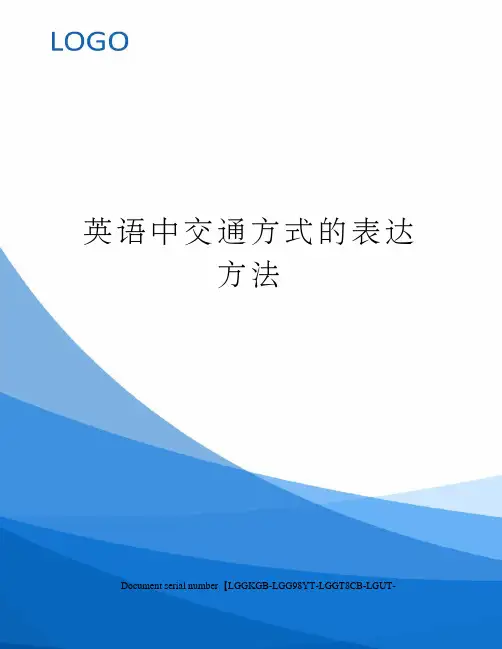
英语中交通方式的表达方法Document serial number【LGGKGB-LGG98YT-LGGT8CB-LGUT-英语中交通方式的表达方法:1、用“by+交通工具”表示交通方式。
如:by bike, by bus, by car , by plane , by train , by subway 等。
但是,“步行”用on foot , 而不是by foot.例句:They go to school by subway every day .他们每天乘地铁去上学。
注意:by后面的交通工具名词是单数,而且名词前面不能加任何修饰词。
2、用"take a +交通工具”表示交通方式。
如:take a bus , take a train , takea ship , 但“骑自行车”要用ride a bike 来表示。
例句:Mr . Smith often takes a train to work .史密斯先生常坐火车去上班。
take + 限定词(如a / the)+交通工具名词"也可表示"乘坐"。
如:You'd better take the No.3 bus to go there.I go to school by bus every day. 我每天坐公共汽车上学。
She takes a bus to go to school every day. 她每天坐公共汽车上学。
3、用某些动词短语来表示交通方式。
如:walk to:步行去;drive to :开车去;ride to :骑马/车去;fly to :乘飞机去等。
注意:如果后面接地点副词here , there , home 等,介词to应省去。
例句:I walk to school . You can drive there .4、用"by+水、陆、空等”来表示交通方式。
如:by water :从水路;by land :经陆路;by sea :经海路;by air:乘飞机等。
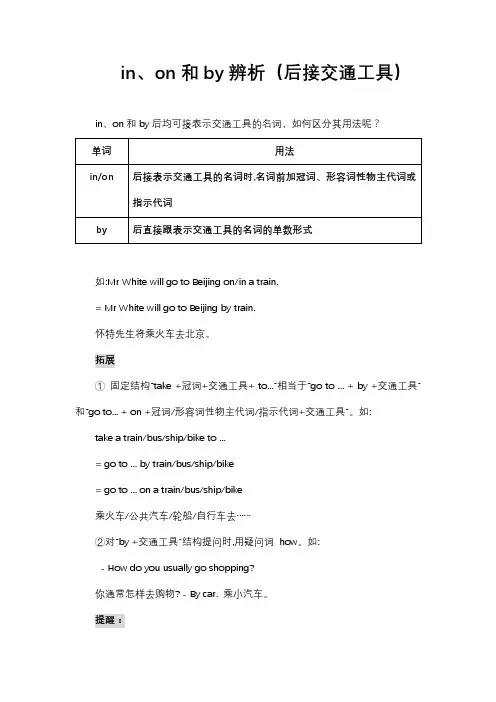
in、on和by辨析(后接交通工具)in、on和by后均可接表示交通工具的名词,如何区分其用法呢?如:Mr White will go to Beijing on/in a train.= Mr White will go to Beijing by train.怀特先生将乘火车去北京。
拓展①固定结构“take +冠词+交通工具+ to...”相当于“go to ... + by +交通工具”和“go to... + on +冠词/形容词性物主代词/指示代词+交通工具”。
如: take a train/bus/ship/bike to ...= go to ... by train/bus/ship/bike= go to ... on a train/bus/ship/bike乘火车/公共汽车/轮船/自行车去……②对“by +交通工具”结构提问时,用疑问词how。
如:- How do you usually go shopping?你通常怎样去购物? - By car. 乘小汽车。
提醒:固定结构“by +交通工具”意为“乘……”,此时表示交通工具的名词前不加任何限定词,且要用单数形式。
如:My mother goes to Beijing by train.我的妈妈乘火车去北京。
经典例题解析例I usually ride __ bike to school, But this morning, I went to school bus.A. a; theB. the; aC. /; aD. a; /解析:句意:我通常骑自行车去上学。
但是今天早上,我是坐公交车去上学的。
ride a bike意为“骑自行车”,by与表示交通工具的名词连用时,名词前不用冠词。
答案:D 解题方法:语法判定法例I go to work ____ bus every morning.A.inB. onC. atD. by解析:“by +交通工具”意为“乘……”;in/on后跟交通工具时,须加冠词、形容词性物主代词或指示代词。
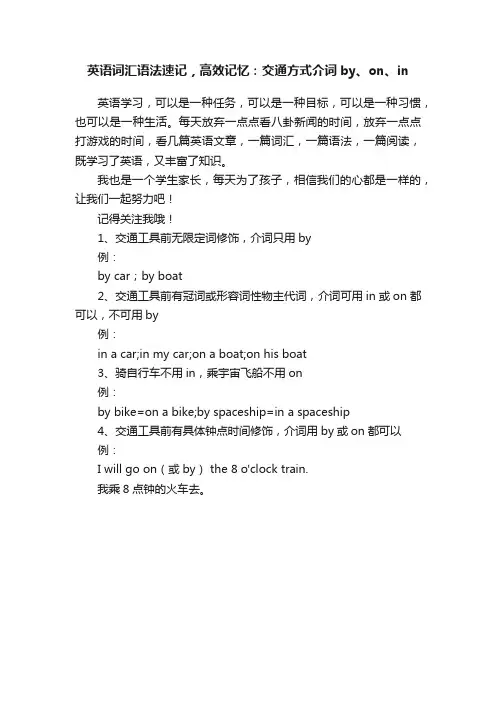
英语词汇语法速记,高效记忆:交通方式介词by、on、in
英语学习,可以是一种任务,可以是一种目标,可以是一种习惯,也可以是一种生活。
每天放弃一点点看八卦新闻的时间,放弃一点点打游戏的时间,看几篇英语文章,一篇词汇,一篇语法,一篇阅读,既学习了英语,又丰富了知识。
我也是一个学生家长,每天为了孩子,相信我们的心都是一样的,让我们一起努力吧!
记得关注我哦!
1、交通工具前无限定词修饰,介词只用by
例:
by car;by boat
2、交通工具前有冠词或形容词性物主代词,介词可用in或on都可以,不可用by
例:
in a car;in my car;on a boat;on his boat
3、骑自行车不用in,乘宇宙飞船不用on
例:
by bike=on a bike;by spaceship=in a spaceship
4、交通工具前有具体钟点时间修饰,介词用by或on都可以
例:
I will go on(或by) the 8 o'clock train.
我乘8点钟的火车去。
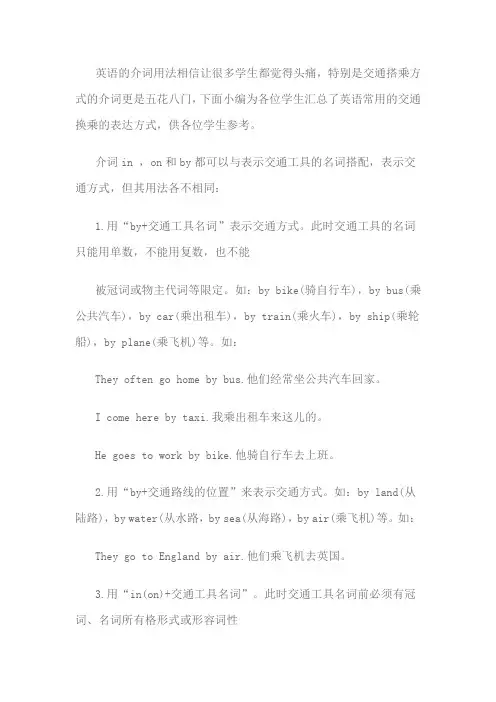
英语的介词用法相信让很多学生都觉得头痛,特别是交通搭乘方式的介词更是五花八门,下面小编为各位学生汇总了英语常用的交通换乘的表达方式,供各位学生参考。
介词in ,on和by都可以与表示交通工具的名词搭配,表示交通方式,但其用法各不相同:1.用“by+交通工具名词”表示交通方式。
此时交通工具的名词只能用单数,不能用复数,也不能被冠词或物主代词等限定。
如:by bike(骑自行车),by bus(乘公共汽车),by car(乘出租车),by train(乘火车),by ship(乘轮船),by plane(乘飞机)等。
如:They often go home by bus.他们经常坐公共汽车回家。
I come here by taxi.我乘出租车来这儿的。
He goes to work by bike.他骑自行车去上班。
2.用“by+交通路线的位置”来表示交通方式。
如:by land(从陆路),by water(从水路,by sea(从海路),by air(乘飞机)等。
如:They go to England by air.他们乘飞机去英国。
3.用“in(on)+交通工具名词”。
此时交通工具名词前必须有冠词、名词所有格形式或形容词性物主代词等限定词修饰。
其用法与“by+交通工具名词”相似。
如:He often goes to school on a(his)bike.他经常骑自行车去上学。
Don‘t come here on /in the ship.不要坐船来这里。
We go there in a car.我们乘小汽车去那里。
4.用“take a(the)+交通工具名词”表示交通方式。
如:take a bus(乘公共汽车),take atrain(乘火车),take a ship(乘轮船),take a plane(乘飞机);但“骑自行车”要用 ride abike来表示。
如:Will you take a bus to go there?你乘汽车去那儿吗?5.表示“步行去某地”,可用下列两种句式:(1)go to +某地+ on foot。

交通工具及“规则”一、介词规则(一)by条款:骑车、乘(驾)车、乘船、乘飞机可以使用介词by。
1、by后跟"光棍"名词,即名词不加任何修饰。
如:by bike/bus/car/train/ship/boat/plane。
如:Sheis going to the Great Wall (长城) by car/ bus.2、by ship 可用by sea表示;by plane 可以用by air 表示。
如:a. How long does it take by ship/sea?b. They often come back by plane/air.(二)in/on条款:步行、骑车、乘车、乘船、乘飞机可以使用介词in/on。
1.步行只可用on foot。
(注意:步行不用by foot)如:Sometimes I go to school on foot.2. 骑自行车须用介词on :ona/ one's bike。
3.乘车、乘船、乘飞机可用in也可用on:in/on a bus/train/ship/boat/plane。
4. 乘坐小汽车应使用in a car,不用on a car。
说明(一)1. "by +名词"短语,多可以用in/on 短语替换来表示"骑、乘"之意。
如:a. His father goes to work by bike. →Hisfather goes to work on a bike.b. They go to the railway station(火车站) by car. →They go to the railway station in a car.2. by sea,by air 是一种比较随便的口语结构,故不宜用in 短语和on短语进行改写。
即:by sea 不可用in/on the sea 替换;by air不可用in/on the air 替换。
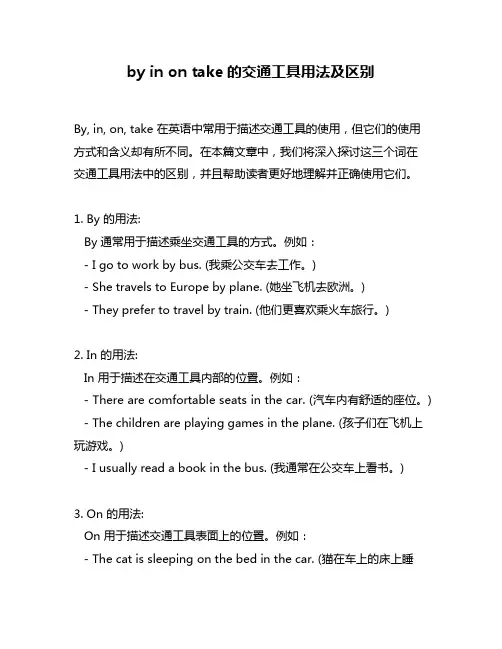
by in on take的交通工具用法及区别By, in, on, take 在英语中常用于描述交通工具的使用,但它们的使用方式和含义却有所不同。
在本篇文章中,我们将深入探讨这三个词在交通工具用法中的区别,并且帮助读者更好地理解并正确使用它们。
1. By 的用法:By 通常用于描述乘坐交通工具的方式。
例如:- I go to work by bus. (我乘公交车去工作。
)- She travels to Europe by plane. (她坐飞机去欧洲。
)- They prefer to travel by train. (他们更喜欢乘火车旅行。
)2. In 的用法:In 用于描述在交通工具内部的位置。
例如:- There are comfortable seats in the car. (汽车内有舒适的座位。
) - The children are playing games in the plane. (孩子们在飞机上玩游戏。
)- I usually read a book in the bus. (我通常在公交车上看书。
)3. On 的用法:On 用于描述交通工具表面上的位置。
例如:- The cat is sleeping on the bed in the car. (猫在车上的床上睡觉。
)- There is a blanket on her lap in the plane. (她的膝盖上有一条毯子。
)- He's standing on the platform waiting for the train. (他站在站台上等火车。
)4. Take 的用法:Take 表示搭乘或乘坐交通工具。
例如:- I take the subway to work every day. (我每天坐地铁上班。
)- She takes a taxi to the airport. (她坐出租车去机场。
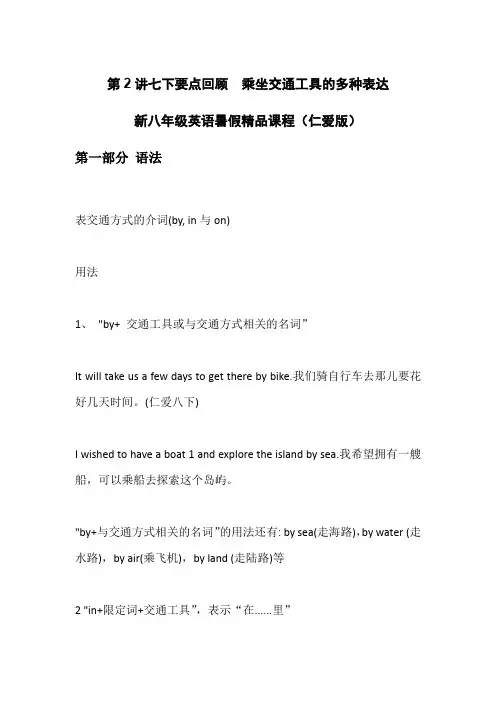
第2讲七下要点回顾乘坐交通工具的多种表达新八年级英语暑假精品课程(仁爱版)第一部分语法表交通方式的介词(by, in与on)用法1、"by+ 交通工具或与交通方式相关的名词”It will take us a few days to get there by bike.我们骑自行车去那儿要花好几天时间。
(仁爱八下)I wished to have a boat 1 and explore the island by sea.我希望拥有一艘船,可以乘船去探索这个岛屿。
"by+与交通方式相关的名词”的用法还有: by sea(走海路),by water (走水路),by air(乘飞机),by land (走陆路)等2 "in+限定词+交通工具”,表示“在......里”Carl's dad saw me on the street and gave me a lift in his car.卡尔的爸爸在街上看见了我,便载了我一一程。
You can study in the train on the way to school.你可以在去学校路上的火车上学习。
3 "on+限定词+交通工具”,表示“在......上”I like going to school on my bike.我喜欢骑自行车去上学。
该用法还有: on a horse (骑马),on the donkey(骑驴)等:但on foot (步行)为习惯用法,不加限定词4.用某些动词短语来表示交通方式。
如:walk to步行去;drive to开车去;ride to 骑马去、骑车去;fly to乘飞机去。
注意:如果后边接地点副词here,there,home等,不用介词to。
如:You can drive here.出行方式汇总:步行on foot walk to骑自行车by bike on a bike ride a bike乘公共汽车by bus on a bus take a bus乘小汽车by car in a car drive a car乘船by boat ship/sea on a boat ship乘地铁by subway in a subway take the subway 乘火车by train in/on a train take the train乘飞机by plane/ air in/on a plane fly to第二部分交通方式表达专项训练(含解析)一、单项选择1.My family often go to the park______bike_______spring.A.on; at B.by; at C.on; in D.by; in2.The People's Park is a little far from here. You can get there _________ the bus.A.by B.on C.to D.for3.They can go to the Century Park ______ underground.A.take B.by C.in D.on4.—does it take to get to school ? —It takes about 15 minutes foot .A.How far ; on B.How long ; on C.How often ; by5.—How do you usually come to school?—I usually ______ a bike. Sometimes I come ______ my mother’s car. A.by; by B.ride; by C.by; in D.ride; in6.Mr Brown usually drive to the park on Sundays. But today he goes to the park_____ foot.A.in B.on C.by D.Of7.--How do you usually______school?--I usually go to school______the school bus.A.get to; take B.get: by C.get to; on D.get to; by8.That place is far from here.It's best to go there ________ bus.A.to B.byC.of D.on9.Her mother goes to work ________ bus every morning. A.by B.at C.on10.---Do you usually go to school _______ bike?---No, I go to school ______ my father’s car.A.by; to B.in; by C.in; in D.by; in 11.Mr Wang often goes to work___________.A.by a bus B.takes the busC.by bus D.take a bus12.Jill goes to school ________ her bike every day.A.in B.on C.with D.by13.—Does your mother go to work ________ car?—No, she often goes to work ________ bike.A.a; a B.by; by C./; a D.in; by14.Do you usually go to school ________ bus or ________ foot? A.by; by B.on; by C.by; on D.on; in 15.—How does Owen usually go to the zoo?—He goes there ________ a bike.A.by B.on C.ride D.to ride16.He wants to go there ______his bike,but I'd like to______ there. A.on;take the undergroundB.by;take an undergroundC.on;on the undergroundD.by;take an underground to17.It takes about thirty minutes from my home to school ______. A.to by underground B.by the undergroundC.to on underground D.on the underground18.My cousin William goes to work ________from Wednesday to Friday. A.by a car B.on his car C.in a car D.by foot 19.—I usually go to school ________ car. How about you?—I often ________a bus to go to school.A.with, by B.on, in C.by, take D.with, take20.—How do your parents go to work?—My father goes to work_______car and my mother________the bus to work.A.by; takes B.take; by C.by; on D.drive; takes二、同义句转化21.I usually take a bus to school. (改写句子,句意不变)I usually go to school ________________.22.Rick rides his bike to school every day. (改写句子,句意不变)Rick goes to school ________ ________ every day.23.Sometimes Dick and Jack drive to work. (改为同义句) Sometimes Dick and Jack go to work ________ ________.三、完成句子24.——去年谁骑自行车周游了五个国家?——米莉的哥哥。

in on by的用法及区别一、介词"in"的用法及区别1. 表示地点:介词"in"常用于表示在某个范围或封闭空间内,例如:- I am in the office.(我在办公室。
)- The book is in the bag.(书在包里。
)2. 表示时间:介词"in"可表示在某个时间段内,在未来的特定日期或年代内。
例如:- We will go on vacation in September.(我们九月份会去度假。
)- She was born in 1990.(她出生于1990年。
)3. 表示状态或情况:介词"in"还可表示身处某种状态或情况中,例如:- He is in a hurry.(他匆忙着。
)- The project is currently in progress.(该项目目前正在进行中。
)4. 表示方式或手段:介词"in"有时可以表示通过某种方式或手段,在某种条件下进行某项活动,例如:- She succeeded in persuading them to agree.(她成功说服他们同意。
)- They communicated with each other in English.(他们用英语交流。
)二、介词"on"的用法及区别1. 表示位置或方位:介词"on"常用来表示表面上方,如平面、道路、建筑物等,例如:- The cup is on the table.(杯子放在桌子上。
)- The cat is sitting on the roof.(猫坐在屋顶上。
)2. 表示时间:介词"on"可表示在某一具体日期、天或星期的某个时间点,例如:- I have a meeting on Monday.(我星期一有个会议。
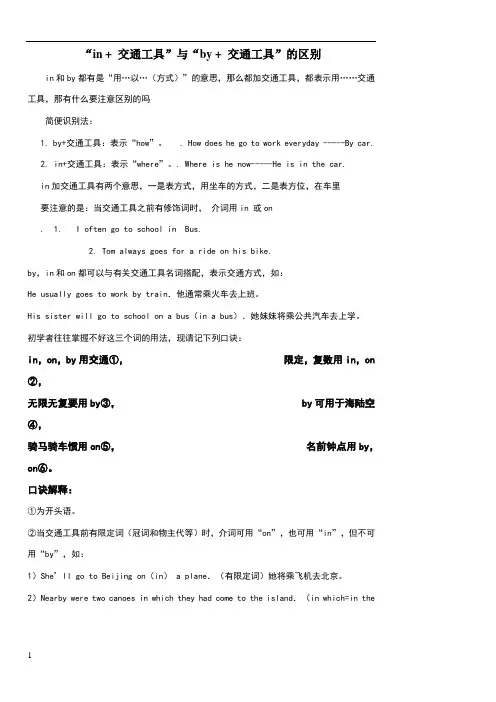
“in + 交通工具”与“by + 交通工具”的区别in和by都有是“用…以…(方式)”的意思,那么都加交通工具,都表示用……交通工具,那有什么要注意区别的吗简便识别法:1. by+交通工具:表示“how”。
. How does he go to work everyday -----By car.2. in+交通工具:表示“where”。
. Where is he now-----He is in the car.in加交通工具有两个意思,一是表方式,用坐车的方式,二是表方位,在车里要注意的是:当交通工具之前有修饰词时,介词用in 或on. 1. I often go to school in Bus.2. Tom always goes for a ride on his bike.by,in和on都可以与有关交通工具名词搭配,表示交通方式,如:He usually goes to work by train.他通常乘火车去上班。
His sister will go to school on a bus(in a bus).她妹妹将乘公共汽车去上学。
初学者往往掌握不好这三个词的用法,现请记下列口诀:in,on,by用交通①,限定,复数用in,on ②,无限无复要用by③, by可用于海陆空④,骑马骑车惯用on⑤,名前钟点用by,on⑥。
口诀解释:①为开头语。
②当交通工具前有限定词(冠词和物主代等)时,介词可用“on”,也可用“in”,但不可用“by”,如:1)She’ll go to Beijing on(in) a plane.(有限定词)她将乘飞机去北京。
2)Nearby were two canoes in which they had come to the island.(in which=in thecanoes)(复数)附近有两只他们来这个岛乘坐的独木船。
③当表示交通工具的名词前没有限定词,而且此名词又不是复数形式时,介词用“by”:Leonov got to the moon by spaceship.列昂诺夫是乘宇宙飞船登上月球的。
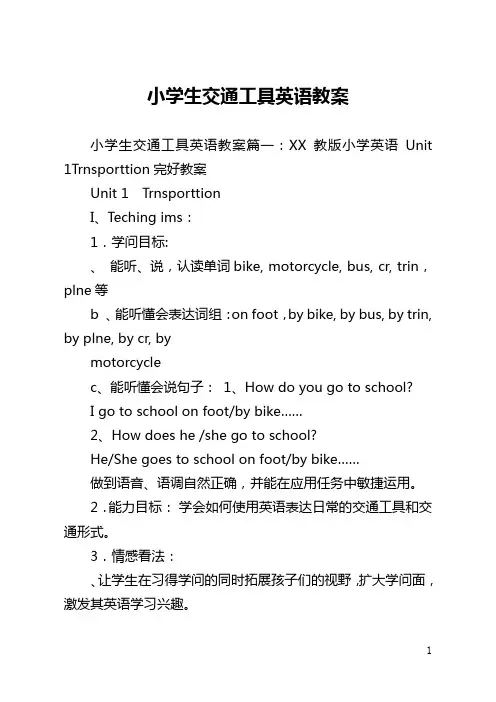
小学生交通工具英语教案小学生交通工具英语教案篇一:XX教版小学英语Unit 1Trnsporttion完好教案Unit 1 TrnsporttionI、Teching ims:1.学问目标:、能听、说,认读单词bike, motorcycle, bus, cr, trin,plne等b 、能听懂会表达词组:on foot,by bike, by bus, by trin, by plne, by cr, bymotorcyclec、能听懂会说句子:1、How do you go to school?I go to school on foot/by bike……2、How does he /she go to school?He/She goes to school on foot/by bike……做到语音、语调自然正确,并能在应用任务中敏捷运用。
2.能力目标:学会如何使用英语表达日常的交通工具和交通形式。
3.情感看法:、让学生在习得学问的同时拓展孩子们的视野,扩大学问面,激发其英语学习兴趣。
b、让孩子们在使用英语进行交际的过程中,养成遵守时间、遵守交通规则的好习惯。
II、Difficult points:1、2、3、4、Trin,plne 等单词的发音。
On foot 词组与其他词组的区分。
区分do和does 的用法。
能听懂会说并敏捷运用句子1、How do you go to school?I go to school on foot/by bike……2、How does he /she go to school?He/She goes to school on foot/by bike……III、Teching ids:单词卡片、多媒体电教室,教学图片IV、Teching steps:一、Wrm-up〔1〕、Greeting nd free tlk〔边复习之前重点句型〕Good morning ,everyone.When do you get up?When do you hve brekfst?Wht do you hve for brekfst?How is the wether tody?How do you sy’圣诞节欢乐’?〔引入上节课内容复习〕〔2〕、Review出示圣诞老人,圣诞树复习单词I m the fther Christms,wht present do you wnt?T 出示图片机器人,电脑,洋娃娃等复习上节课所学引出自行车bikebike是一种交通工具引出课题Trnsporttion二、Presenttion1、导入课题I m the fther Christms,wht present do you wnt?T 出示图片机器人,电脑,洋娃娃等复习引出自行车bike 教读bike引出课题Trnsporttion2、教读课题Trnsporttion3、教读单词Bike :Cn you ride bike? Do you hve bike? 顺便复习前几个重点句型。
英语语法介词如何表示交通工具介词在英语语法中也被广泛用于表示交通工具,帮助我们描述乘坐或使用不同类型的交通工具。
下面是介词在表示交通工具方面的常见用法:1. by:-用于表示乘坐某种交通工具(We traveled by plane to the destination,我们乘飞机到达目的地)。
-用于表示使用某种交通工具(He commutes to work by train,他通勤乘火车上班)。
2. on:-用于表示乘坐某种交通工具(She is on the bus heading to downtown,她坐公交车去市区)。
-用于表示使用某种交通工具(He is on a bicycle,他骑自行车)。
3. in:-用于表示乘坐某种交通工具(We are in a taxi on our way to the airport,我们乘出租车去机场)。
-用于表示使用某种交通工具(He is in a car,他开车)。
4. by means of:-用于表示通过某种交通工具(They traveled by means of a private jet,他们乘坐私人飞机旅行)。
-用于表示通过某种手段或方法(They communicated by means of email,他们通过电子邮件进行沟通)。
5. via:-用于表示通过某个地点或途径(We flew to London via Paris,我们经巴黎飞往伦敦)。
-用于表示通过某种交通工具(He traveled from New York to Los Angeles via train,他乘火车从纽约到洛杉矶)。
6. with:-用于表示乘坐某种交通工具(She traveled with her friends by car,她和朋友们一起开车旅行)。
-用于表示使用某种交通工具(He goes to work with a scooter,他骑着踏板车上班)。
初中英语课外辅导:“乘坐”的讲究英语中表示"乘坐"交通工具的有两种词类,即介词的“乘”和动词的“乘”。
你得比较选用--1. by①by + 交通工具名词,表示“乘坐”。
如:by bus, by bike, by plane, by train, by car, by taxi, by ship等。
② by + 地理名词,表示“通过;由……途径”,此时表示旅行方式,而不涉及交通工具。
如:by sea (从海路),by air (由航空、坐飞机) 等。
【注意】在英语中,要表示乘坐某种交通工具可用by。
介词by表示“乘”时,其后可直接跟表示交通工具的名词,该名词前不能有代词或冠词修饰。
2. in,on介词in (on) + 冠词(形容词性物主代词等) + 交通工具名词也可表示“乘、坐”。
in 多用于带舱或车厢的交通工具名词前,侧重于封闭式的交通工具;on 多用于开放式或半封闭式的交通工具。
如:They often go to the farm on a bike. 他们通常骑自行车去农场。
One day, you can go to the moon in a spaceship. 总有一天,你们可以乘宇宙飞船上月球。
【注意】骑自行车常用on a bike或by bike,而不能用in a bike。
骑马、骑骆驼等用on,如:on a horse, on the camel等。
在表示交通工具的名词前若有具体的时刻修饰时,则用介词by或on均可。
如:by (on) the 7:00 bus.3. take“take + 限定词(如a / the)+交通工具名词”也可表示“乘坐”。
如:You'd better take the No.3 bus to go there. 你最好乘3路公共汽车去那儿。
I go to school by bus every day. 我每天坐公共汽车上学。
初中英语交通“乘坐”的讲究by, in, on, take区别初中英语课外辅导:“乘坐”的讲究英语中表示"乘坐"交通工具的有两种词类,即介词的“乘”和动词的“乘”。
你得比较选用--1. by①by + 交通工具名词,表示“乘坐”。
如:by bus, by bike, by plane, by train, by car, by taxi, by ship等。
② by + 地理名词,表示“通过;由……途径”,此时表示旅行方式,而不涉及交通工具。
如:by sea (从海路),by air (由航空、坐飞机) 等。
【注意】在英语中,要表示乘坐某种交通工具可用by。
介词by表示“乘”时,其后可直接跟表示交通工具的名词,该名词前不能有代词或冠词修饰。
2. in,on介词in (on) + 冠词(形容词性物主代词等) + 交通工具名词也可表示“乘、坐”。
in多用于带舱或车厢的交通工具名词前,侧重于封闭式的交通工具;on 多用于开放式或半封闭式的交通工具。
如:They often go to the farm on a bike. 他们通常骑自行车去农场。
One day, you can go to the moon in a spaceship. 总有一天,你们可以乘宇宙飞船上月球。
【注意】骑自行车常用on a bike或by bike,而不能用in a bike。
骑马、骑骆驼等用on,如:on a horse, on the camel等。
在表示交通工具的名词前若有具体的时刻修饰时,则用介词by或on均可。
如:by (on) the 7:00 bus.3. take“take + 限定词(如a / the)+交通工具名词”也可表示“乘坐”。
如:You'd better take the No.3 bus to go there. 你最好乘3路公共汽车去那儿。
I go to school by bus every day. 我每天坐公共汽车上学。
初中英语课外辅导:“乘坐”的讲究英语中表示"乘坐"交通工具的有两种词类,即介词的“乘”和动词的“乘”。
你得比较选用--1. by①by + 交通工具名词,表示“乘坐”。
如:by bus, by bike, by plane, by train, by car, by taxi, by ship等。
② by + 地理名词,表示“通过;由……途径”,此时表示旅行方式,而不涉及交通工具。
如:by sea (从海路),by air (由航空、坐飞机) 等。
【注意】在英语中,要表示乘坐某种交通工具可用by。
介词by表示“乘”时,其后可直接跟表示交通工具的名词,该名词前不能有代词或冠词修饰。
2. in,on介词in (on) + 冠词(形容词性物主代词等) + 交通工具名词也可表示“乘、坐”。
in多用于带舱或车厢的交通工具名词前,侧重于封闭式的交通工具;on 多用于开放式或半封闭式的交通工具。
如:They often go to the farm on a bike. 他们通常骑自行车去农场。
One day, you can go to the moon in a spaceship. 总有一天,你们可以乘宇宙飞船上月球。
【注意】骑自行车常用on a bike或by bike,而不能用in a bike。
骑马、骑骆驼等用on,如:on a horse, on the camel等。
在表示交通工具的名词前若有具体的时刻修饰时,则用介词by或on均可。
如:by (on) the 7:00 bus.3. take“take + 限定词(如a / the)+交通工具名词”也可表示“乘坐”。
如:You'd better take the No.3 bus to go there. 你最好乘3路公共汽车去那儿。
I go to school by bus every day. 我每天坐公共汽车上学。
i n交通工具与b y交通工具之间的区别The latest revision on November 22, 2020“in + 交通工具”与“by + 交通工具”的区别in和by都有是“用…以…(方式)”的意思,那么都加交通工具,都表示用……交通工具,那有什么要注意区别的吗简便识别法:1. by+交通工具:表示“how”。
. How does he go to work everyday -----By car.2. in+交通工具:表示“where”。
. Where is he now-----He is in the car.in加交通工具有两个意思,一是表方式,用坐车的方式,二是表方位,在车里要注意的是:当交通工具之前有修饰词时,介词用in 或on.1. I often go to school in Bus.2. Tom always goes for a ride on his bike.by,in和on都可以与有关交通工具名词搭配,表示交通方式,如:He usually goes to work by train.他通常乘火车去上班。
His sister will go to school on a bus(in a bus).她妹妹将乘公共汽车去上学。
初学者往往掌握不好这三个词的用法,现请记下列口诀:in,on,by用交通①,限定,复数用in,on②,无限无复要用by③, by可用于海陆空④,骑马骑车惯用on⑤,名前钟点用by,on⑥。
口诀解释:①为开头语。
②当交通工具前有限定词(冠词和物主代等)时,介词可用“on”,也可用“in”,但不可用“by”,如:1)She’ll go to Beijing on(in) a plane.(有限定词)她将乘飞机去北京。
2)Nearby were two canoes in which they had come to the island.(in which=in the canoes)(复数)附近有两只他们来这个岛乘坐的独木船。
“in + 交通工具”与“by + 交通工具”的区别in和by都有是“用…以…(方式)”的意思,那么都加交通工具,都表示用……交通工具,那有什么要注意区别的吗简便识别法:1. by+交通工具:表示“how”。
e.g. How does he go to work everyday? -----By car.2. in+交通工具:表示“where”。
e.g. Where is he now?-----He is in the car.in加交通工具有两个意思,一是表方式,用坐车的方式,二是表方位,在车里?要注意的是:当交通工具之前有修饰词时,介词用in 或one.g. 1. I often go to school in No.1 Bus.2. Tom always goes for a ride on his bike.by,in和on都可以与有关交通工具名词搭配,表示交通方式,如:He usually goes to work by train.他通常乘火车去上班。
His sister will go to school on a bus(in a bus).她妹妹将乘公共汽车去上学。
初学者往往掌握不好这三个词的用法,现请记下列口诀:in,on,by用交通①,限定,复数用in,on②,无限无复要用by③,by可用于海陆空④,骑马骑车惯用on⑤,名前钟点用by,on⑥。
口诀解释:①为开头语。
②当交通工具前有限定词(冠词和物主代等)时,介词可用“on”,也可用“in”,但不可用“by”,如:1)She’ll go to Beijing on(in)a plane.(有限定词)她将乘飞机去北京。
2)Nearby were two canoes in which they had come to the island.(in which=in the canoes)(复数)附近有两只他们来这个岛乘坐的独木船。
学习资料
“in + 交通工具”与“by + 交通工具”的区别
in和by都有是“用…以…(方式)”的意思,那么都加交通工具,都表示用……交通工具,那有什么要注意区别的吗
简便识别法:
1. by+交通工具:表示“how”。
e.g. How does he go to work everyday? -----By car.
2. in+交通工具:表示“where”。
e.g. Where is he now?-----He is in the car.
in加交通工具有两个意思,一是表方式,用坐车的方式,二是表方位,在车里?
要注意的是:当交通工具之前有修饰词时,介词用in 或on
e.g. 1. I often go to school in No.1 Bus.
2. Tom always goes for a ride on his bike.
by,in和on都可以与有关交通工具名词搭配,表示交通方式,如:
He usually goes to work by train.他通常乘火车去上班。
His sister will go to school on a bus(in a bus).她妹妹将乘公共汽车去上学。
初学者往往掌握不好这三个词的用法,现请记下列口诀:
in,on,by用交通①,限定,复数用in,on②,
无限无复要用by③,by可用于海陆空④,
骑马骑车惯用on⑤,名前钟点用by,on⑥。
口诀解释:
①为开头语。
②当交通工具前有限定词(冠词和物主代等)时,介词可用“on”,也可用“in”,但不可用“by”,如:
1)She’ll go to Beijing on(in)a plane.(有限定词)她将乘飞机去北京。
2)Nearby were two canoes in which they had come to the island.(in which=in the canoes)(复数)附近有两只他们来这个岛乘坐的独木船。
③当表示交通工具的名词前没有限定词,而且此名词又不是复数形式时,介词用“by”:Leonov got to the moon by spaceship.列昂诺夫是乘宇宙飞船登上月球的。
④介词by和一些与交通有关的名词连用,表示交通方式。
此时,既不能在名词前加限定词,也不能把名词改为复数形式。
再者,介词by也不可以改用in或on。
如:
1)I’m going there by sea.我乘船去。
2)He came to Shanghai by water.他是乘船到上海的。
3)They’ll go there by land.他们将从陆路去那儿。
4)He has returned to Beijing by air.他已乘飞机返回北京。
5)My brother goes to school by bike.我哥哥骑自行车去上学。
⑤on horsebact(骑马)是固定搭配,“on”不能改为in或by。
既不能在horseback前加限定词,也不能把horseback改为复数形式。
如:
He saw two men on horseback.他看到了两个骑马的人。
另外,on与限定词加bike连用时,不能改为in或by,如:
They go to work on their bikes.他们是骑自行车上班的。
⑥如果表示交通工具的名词前有具体的钟点时间修饰时,介词用“by”或“on”。
如:
I’ll go on(by)the 9 o’c lock train.我将乘九点钟的火车去
仅供学习与参考。